Yoshida Shoin:
The Archetype of Japanese Revolutionaries
By Romulus Hillsborough
Editor's
Note: This is the third article on famous Japanese Samurai
leaders who, at the end of Japan’s feudal period, defied death
and personal safety to help forge a new Japan. Prior articles included “Sakamoto
Ryoma: The Indispensable Nobody” and "Katsu Kaishu: The Man
Who Saved Early Modern Japan." Yoshida Torajiro (best known by his
pen name Shoin), the subject of this article, was a principal intellectual
protagonist of the Meiji Restoration of 1868 whose heroism and writings
brought him much acclaim He was one among a group of Samurai leaders
drawn from various clans whose beliefs, statesmanship and actions instigated
dramatic changes in Japan following Commodore Perry’s naval intrusion
-- the overthrow of the military government (1868), institution of a
parliamentary government, and modernization – that virtually overnight
turned a feudal society toward a progressive modern age.
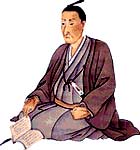 If
the tenet of certain age-old philosophies is true that the physical
environment at birth has an ominous effect on the future personality
and life of the newborn child, then perhaps it was the sweltering
heat of the Hagi [referring to the castle down of Hagi - ed.] summer
that lit the flame of passion in Yoshida Shoin’s indomitable
spirit for a new and stronger Japan — a passion which would
neither be extinguished by the cold steel of the executioner’s
sword some twenty-nine years later, nor by the passing of nearly
one century and a half since his tragic death. For not only has Choshu’s
[one of the principal military domains in feudal Japan - ed.] most
beloved samurai been immortalized in the annals of Japanese history,
but his spirit has been sanctified in numerous hagiographies [literally
meaning the biography of of a Saint, but here used to refer to
biographies of Shoin by others - ed.] his lofty aspirations recorded
in copious
biographies, his memory canonized in paintings and statuettes which
to this day grace the alters of countless homes throughout the
Yamaguchi countryside [the modern Yamaguchi prefecture that replaced
the Choshu
domian - ed.] where the charismatic genius came into this world. If
the tenet of certain age-old philosophies is true that the physical
environment at birth has an ominous effect on the future personality
and life of the newborn child, then perhaps it was the sweltering
heat of the Hagi [referring to the castle down of Hagi - ed.] summer
that lit the flame of passion in Yoshida Shoin’s indomitable
spirit for a new and stronger Japan — a passion which would
neither be extinguished by the cold steel of the executioner’s
sword some twenty-nine years later, nor by the passing of nearly
one century and a half since his tragic death. For not only has Choshu’s
[one of the principal military domains in feudal Japan - ed.] most
beloved samurai been immortalized in the annals of Japanese history,
but his spirit has been sanctified in numerous hagiographies [literally
meaning the biography of of a Saint, but here used to refer to
biographies of Shoin by others - ed.] his lofty aspirations recorded
in copious
biographies, his memory canonized in paintings and statuettes which
to this day grace the alters of countless homes throughout the
Yamaguchi countryside [the modern Yamaguchi prefecture that replaced
the Choshu
domian - ed.] where the charismatic genius came into this world.
|
Yoshida Shoin was born the second son of a lower ranking samurai in
the village of Matsumoto, amidst the verdant foothills of the castle
town of Hagi, center of the great domain of Choshu, by the aquamarine
Sea of Japan, in the eighth month of the first year of the Era of Heaven’s
Protection — or more simply put, August 1830.
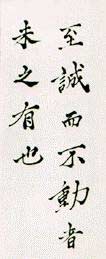 |
Shoin’s motto and
calligraphy, "Sincerity and perseverance always win," the
dictum borrowed from the Chinese philosopher Mencius.
|
|
“He knew nothing of anger,” a former student would recall. “He
was kind to others… and had a polite manner of speech.” Yoshida
Shoin was physically frail, soft-spoken and a master of self-control
whose willpower knew no bounds. He was an avid scholar who denied himself
sleep, and who was known to stand or walk in the snow to keep himself
awake for his studies. At age five Shoin began the formal study of military
tactics and the Chinese classics. By age eight he was studying the Confucian
philosophy of Meng-tzu, and began attending the official college of the
Choshu domain. In the following year he taught at the college. At age
ten he won praise from the Lord of Choshu for his recital of the military
classics. At fifteen he became awakened to the dangerous goings on in
the world outside the sacred Empire of Yamato [Japan - ed.]. In 1848,
five years before the arrival of Perry, he advised the Lord of Choshu
to prepare
for foreign invasion. In 1851, his twenty-first year, Shoin accompanied
the Lord of Choshu to the Shogun’s capital at Edo [now Tokyo -
ed.], where he studied under Sakuma Shozan, the most celebrated Western
military scientist in Japan.
Shoin was in Edo when Commodore Matthew Perry of
the United States Navy arrived in June 1853. Perry led a squadron of
heavily
armed warships
into the bay off the Shogun’s [the military leader of Japan who
was during this time the head of the Tokugawa clan - ed.] capital, demanding
an end of Japanese isolation and inciting fifteen years of
bloody turmoil throughout the island nation.
Shoin learned from Shozan
the futility of challenging the modern military power of the West with
Japan’s ancient arts of war. He adopted his teacher’s belief
in the aphorism “Know the enemy” in order to “control
the barbarians through barbarian technology.” But the Tokugawa
Shogunate did not have the wherewithal to reject Perry’s demands.
Rather than remain idle while bumbling Tokugawa officials sealed the
fate of the Japanese nation, Shoin, with the help of his revered teacher,
planned drastic measures.
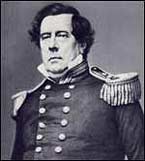 |
Commodore Perry
|
|
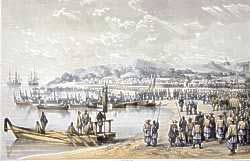 |
Perry’s first landing
on Japanese soil
|
|
Perry concluded Japan’s first treaty with the United
States in March 1854. Shortly after, his squadron lay in the harbor at
Shimoda,
one of two ports opened under the terms of the treaty, from which it
would soon depart.
Shoin prepared a letter for Perry, which he and a fellow Choshu samurai
delivered to American officers on land, under the cover of night. Perry
described the incident: [They] “were observed to be men of some
position and rank, as each wore the two swords characteristic of distinction,
and were dressed in the wide but short trowsers of rich silk brocade.
Their manner showed the usual courtly refinement of the better classes,
but they exhibited the embarrassment of men who evidently were not perfectly
at their ease, and were about doing something of dubious propriety. They
cast their eyes stealthily about as if to assure themselves that none
of their countrymen were at hand to observe their proceedings, and then
approaching one of the officers and pretending to admire his watch-chain,
slipped within the breast of his coat a folded paper.”
The “folded paper,” written in “the mandarin Chinese
with fluency and apparent elegance,” and translated by Perry’s
interpreter, was as moving in its humble tone as it was compelling. “Two
scholars from Yedo, in Japan, present this letter for the inspection
of ‘the high officers and those who manage affairs.’ Our
attainments are few and trifling, as we ourselves are small and unimportant,
so that we are abashed in coming before you; we are neither skilled in
the use of arms, nor are we able to discourse upon the rules of strategy
and military discipline… we have been for many years desirous of
going over the ‘five great continents,’ but the laws of our
country in all maritime points are very strict; for foreigners to come
into the country, and for natives to go abroad, are both immutably forbidden. “…we
now secretly send you this private request, that you will take us on
board your ships as they go out to sea.”
 |
The USS Mississippi
|
Although Perry would never
know Yoshida Shoin’s name, his identity
or his ultimate fate, he was sufficiently impressed by the idealistic
young man’s bold attempt to defy “the eccentric and sanguinary
code of Japanese law,” to record an account of it: “During
the succeeding night, about two o’clock a.m… the officer
of the midwatch, on board the steamer Mississippi, was aroused by a voice
from a boat alongside, and upon proceeding to the gangway, found a couple
of Japanese, who had mounted the ladder at the ship’s side, and
upon being accosted, made signs expressive of a desire to be admitted
on board. “They seemed very eager to be allowed to remain, and
showed a very evident determination not to return to the shore.”
Refused by Perry, the two samurai were apprehended by the Japanese authorities,
and confined to a cage. They nevertheless managed to relay a message
to the Americans, “a remarkable specimen of philosophical resignation
under circumstances which would have tried the stoicism of Cato…[the
ancient Roman statesman and politician - ed.]” The message begins: “When
a hero fails in his purpose, his acts are then regarded as those of a
villain and robber. In public have we been seized and pinioned and caged
for many days… Therefore, looking up while yet we have nothing
wherewith to reproach ourselves, it must now be seen whether a hero will
prove himself to be one indeed.” Shoin’s heroics would become
self-evident soon enough, but first he would be transported to the jail
in Edo, and returned as a prisoner to Hagi.
 |
Towsend
Harris
|
In summer 1856, American envoy Townsend Harris of the United States
established the first American Consulate in Japan at a Buddhist temple
in Shimoda to negotiate Japan’s first commercial treaty. Protocol
demanded that the shogunate could only sign a treaty after receiving
permission from the Imperial Court at Kyoto. As a commercial treaty with
the United States materialized, opposition grew among proponents of Expelling
the Barbarians, who now rallied around the Kyoto court.
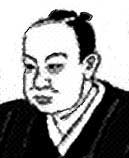 |
Il Naksuke
|
These xenophobes
called themselves Imperial Loyalists. Pitted against them were the
proponents of Opening the Country, led by Ii Naosuke, the powerful
Lord of Hikone
[the feudal domain - ed.]. Japan split into two factions.
The Loyalists claimed that the Shogun was merely an Imperial agent,
who at the beginning of the seventeenth century had been commissioned
by the Emperor to protect Japan from foreign invasion. They claimed that
true political authority rested with the Emperor, and that the Tokugawa
could only justify its rule by expelling the foreigners. They argued
that since the Shogun was no longer capable of fulfilling this ancient
duty, the Emperor and his court must be restored to power to save the
nation. As a result, the national government developed into a twofold
structure: while the shogunate continued to rule at Edo, the Imperial
Court was undergoing a political renaissance in its ancient capital at
Kyoto.
When the Edo authorities petitioned Kyoto to sanction the commercial
treaty, they were flatly refused. In April 1858, Ii Naosuke was appointed
Tokugawa Regent, making him head of the Shogun’s council and arbitrary
ruler of the military government. In June Regent Ii realized a commercial
treaty with the United States without Imperial sanction, and pandemonium
ensued.
After spending over a year in prison, Shoin was placed under house confinement.
In November 1857, he established his progressive Sho-ka-son-juku – Village
School Under the Pines – and thereby secured his place in Japanese
history.
Shoin On Leadership
What is important in a leader
is a resolute will and determination. A man may be versatile
and learned, but if he lacks resoluteness and determination,
of what use will he be?
*
Once the will is resolved,
one’s spirit is strengthened. Even a peasant s will
is hard to deny, but a samurai of resolute will can sway
ten thousand men.
*
One who aspires to greatness
should read and study, pursuing the True Way with such
a firm resolve that he is perfectly straightforward and
open, rises above the superficialities of conventional
behavior, and refuses to be satisfied with the petty or
commonplace.
*
Once a man’s will
is set, he need no longer rely on others or expect anything
from the world. His vision encompasses Heaven and earth,
past and present, and the tranquility of his heart is undisturbed.
*
Life and death, union and
separation, follow hard upon one another. Nothing is steadfast
but the will, nothing endures but one’s achievements.
These alone count in life. To consider oneself different
from ordinary men is wrong.
|
|
As samurai throughout Japan ranted and raved and vowed to kill the “traitors” who
had opened the country to the “barbarians,” Yoshida Shoin
preached Imperial Loyalism to young men of the lower rungs of Choshu
society at his academy in Hagi. He professed that the Emperor was the
true sovereign of Japan. He opened his pupils’ eyes to the dangerous
situation of the world outside. But Master Shoin nevertheless supported
Tokugawa rule, and favored Opening the Country to enrich the nation and
develop a strong military. He advocated a union between Kyoto and Edo
to protect Japan from the threat of foreign subjugation. These ideas
he instilled in the minds of his young disciples. And he was only twenty-seven
years old. And he was very successful, for among his disciples were future
leaders of the revolution which was the Meiji Restoration, including
two prime ministers.
No sooner had Shoin heard the
news of Ii’s “blasphemy,” than
he made a complete turnabout in his political stance, and became the
most radical of zealots who preached Imperial Reverence and Expelling
the Barbarians. He would now “correct” the lese majesty [affront
to the Emperor - ed.] committed by the evil regent. He would take part
in a plot among radicals from other clans to assassinate him, but first,
in
November 1858, he planned to assassinate a Tokugawa councilor whom Ii
had unsuccessfully sent to Kyoto to obtain Imperial sanction for the
commercial treaty.
Shoin’s plan was never realized, for it was determined by the
Choshu authorities that his radicalism threatened the well-being of their
daimyo (the military leader of their domain). In December Shoin was again
imprisoned in Hagi. But he would not compromise his ideals, and from
his cell became more and more defiant. “I am sorry to say,” he
wrote to a friend, “but I have no use for the Imperial Court, the
shogunate, or our clan. The only thing I need is…my own meager
body.” If neither Edo, Kyoto or Choshu would take the appropriate
measures, then this archetype of Japanese revolutionaries would. The
revolution he envisioned would be accomplished through the cooperation
of lower ranking samurai and men from the peasant and merchant classes.
The notion was preposterous in 1858, but more prophetic perhaps than
even Shoin imagined.
Shoin would not live to see the revolution unfold. In the following
May Choshu received orders from the shogunate to send its most dangerous
insurgent to Edo. Shoin reached Edo in June, was imprisoned there in
July. He was questioned by the authorities, who were amazed by his confessions.
Defiant as ever and determined to set the authorities on the proper course,
Shoin not only openly expressed his disdain for the dictatorship of Regent
Ii and his suppression of the Loyalists, but he took it upon himself
to divulge his assassination plans.
Although Shoin’s confession had sealed his fate, even now he did
not expect to die. He was too occupied planning the revolution. What’s
more, his assassination plans had never been realized, and his confession
had been voluntary. “I don’t know what my punishment will
be, but I don’t think it will be execution,” he wrote to
his family in June. It wasn't until mid-October, when three of his comrades
were executed, that Shoin realized his end was near. On October 15 he
wrote a death
poem. Two days later he was informed of his death sentence. He was brought
to an open courtyard adjacent to the prison, and led to the scaffold.
With perfect composure he kneeled atop a straw mat, beyond which was
a rectangular hole dug in the rich, dark earth to absorb the blood. Standing
nearby was the executioner, Yamada Asaemon, his long and short swords
stuck through the sash at his left hip. Asaemon, who beheaded thousands
during his long, illustrious career, was duly impressed by Shoin. “Yoshida
Shoin died a truly noble death,” he would tell his son.
Shoin calmly straightened his clothes. He asked for a piece of tissue
paper to clear his nasal passage, then recited his final death poem: “Parental
love exceeds one’s love for his parents. How will they take the
tidings of today?” The executioner now drew his long sword, and
with one clean stroke severed the head of the archetype of Japanese revolutionaries.
About The Author:
Romulus Hillsborough is a native Californian who lived in Japan for
sixteen years, studying the language, history and culture. He is the
author of RYOMA - Life of a Renaissance Samurai(Ridgeback Press, 1999)
and Samurai Sketches: From the Bloody Final Years of the Shogun (Ridgeback
Press, 2001). RYOMA is the only biographical novel of Sakamoto Ryoma
in the English language. Samurai Sketches is a collection of historical
sketches, never before presented in English, depicting men and events
during the revolutionary years of mid-19th century Japan. Reviews and
more information about these books are available from Ridgeback
Press.
Also see the Samurai History Tour at http://www.ridgebackpress.com/tour.htm.
For more information about Katsu Kaishu and Sakomoto Ryoma see:
“Ryoma - Life of a Renaissance Samurai”
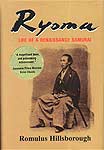
By Romulus Hillsborough
Ridgeback Press
Hardcover, 614 Pages
RBP-B- 2035
$40.00
(Plus $6.00 Shipping Within US)

|